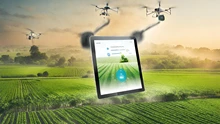
Chandrayaan-3, India's third lunar mission, was launched on July 14, 2023, from the Satish Dhawan Space Centre in Sriharikota. As of July 31, 2023, the spacecraft is in a stable orbit around Earth at 71351 km x 233 km. The Indian Space Research Organisation (ISRO) successfully employed a slingshot effect, using a celestial body's gravity to modify the spacecraft's trajectory, conserving fuel, and gaining valuable insights about Earth and the Moon during its orbits around Earth.
Following the launch of Chandrayaan-3, the spacecraft has begun its final journey towards the Moon. To accomplish this, it first moved away from Earth's orbit and then reached a critical point in the Moon's gravity called 'perigee,' where the Moon's influence on the spacecraft became noticeable. During this phase, Chandrayaan-3's thrusters were employed to adjust its trajectory and enter the Moon's orbit tangentially.
#Chandrayaan2 mission was a highly complex mission, which represented a significant technological leap compared to the previous missions of #ISRO to explore the unexplored south pole of the Moon.
— ISRO (@isro) September 7, 2019
For more updates please visit https://t.co/4vIrztVnng
When Chandrayaan-3 arrives on the Moon, its two primary instruments will take centre stage. These instruments were previously deployed on the lunar surface during the Chandrayaan-2 mission. Just like its predecessor, Chandrayaan-3's lander and rover have been given the names Vikram and Pragyan. Vikram is the lander that will touch down on the moon's surface, and once it lands, the rover Pragyan will emerge from it. The decision to reuse these names was made because the previous mission faced challenges and did not achieve its intended goals on the lunar surface.
Last time, Vikram and Pragyan couldn't function due to the Chandrayaan-2's unfortunate fall and destruction. However, ISRO has now developed advanced technology for Chandrayaan-3, ensuring that the vehicle will only land when a suitable landing site is identified. To achieve this, additional fuel has been incorporated into the vehicle.
The primary objective of Chandrayaan-3 is to explore the Moon's south pole and conduct a detailed study of its surface. Scientists believe that this region holds a substantial amount of water ice and receives ample sunlight. Such exploration is expected to have significant implications for future Mars missions.
What sets this mission apart is that no other space agency has attempted to reach the Moon's south pole before, making it a daring and pioneering endeavor.
What is Lander Vikram And What It Do?
Vikram Lander will become operational upon achieving a soft landing on the lunar surface. A few moments after landing, it will transmit its initial image to ISRO. Throughout its time on the moon, it will remain functional and conduct scientific tasks relevant to lunar exploration.
After approximately three hours of landing, the rover, Pragyan, will emerge from within the lander. This solar-powered rover will move on six wheels and cover a distance of about 500 meters, with a speed of 1 cm per second. Its main objective is to conduct chemical analysis on the moon's surface and send the collected data back to the lander, which will then relay it to ISRO's space station. Pragyan will remain operational for one lunar day, equivalent to 14 Earth days.
What is The Basis of Nomenclature?
The nomenclature of the lander, Vikram, is based on its association with courage and valor, as denoted by its Sanskrit meaning. It's significant that this mission marks the first time any space agency is exploring the south pole of the Moon. Additionally, naming the lander Vikram pays tribute to the renowned scientist Vikram Sarabhai, often referred to as the father of Indian space science programs.
As for the rover, Pragyan, its name is derived from the notion of wisdom and discretion. The decision to name it Pragyan is due to the advanced artificial intelligence technology used in the rover. This technology allows Pragyan to study lunar surface chemicals and generate data autonomously, highlighting its intelligent capabilities.











